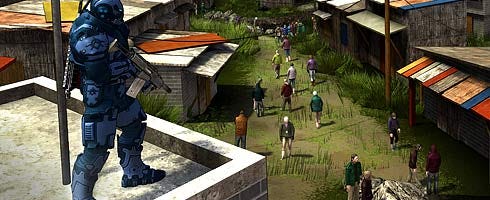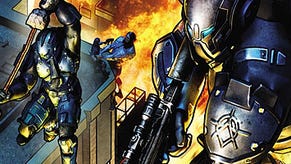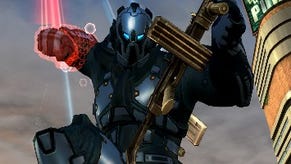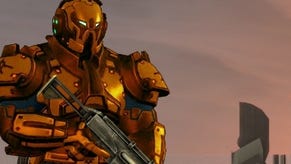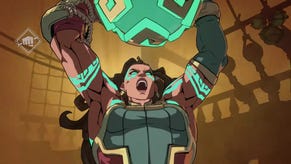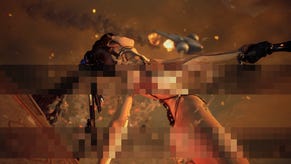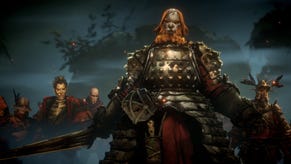Interview, part 2: Crackdown 2 design boss and producer on Pacific City's future
The second part of our Crackdown 2 interview with Ruffian creative director Billy Thomson and producer James Cope is after the break. Get the first part here.
You're using the original Pacific City map. In the very first instance, was that taken to speed up development, or was that a necessary thing to continue the story?
Billy Thomson: Well, it obviously does speed up development. I'm not going to say it doesn’t, because it obviously does, but to be fair, every single block in the game – when I say "block," the whole game's divided into blocks – every single one of the have been touched. Some of them have been deleted, started again and rebuilt. Based on their location and how they fit into the storyline, they've all been touched in one way or another. But the main reason for it was to continue the story on.
When we go to Crackdown 3 things'll alter again. But yeah, for Crackdown 2 it made more sense to stick in the same city, because it is pushing on from the idea of the Freak fires and how they've affected the city. It's not a case of doing it because it's quicker. If anything it's taken just as long to re-do what's already there, because we've got to make sure we don't break what we spent so much time getting right in the first game. It'd actually be easier to start again. It's saved time in some areas, and it's caused a lot of problems in others, so it's almost balanced itself out from a development point of view, but it was a requirement in terms of pushing the story in the direction we wanted to push it.
What about the underground element? I don't think that's even been mentioned before today.
James Cope: No, it hasn't.
How much play area does that actually add to the map?
Billy Thomson: Let me think. If you take one of the locations for a gang boss in the first game, most of them are… let me think of one location that'd be a good size. The Refinery, probably. A little bit smaller than the Refinery. And there's, like, nine of them. It's a big bit of gameplay.
So each one is its own zone, it's own mission, sort of thing?
Billy Thomson: Yeah.
How does that actually affect gameplay? Crackdown's all about "up," right? About jumping up. What happens when you've got a ceiling?
Billy Thomson: Well, it's kind of similar. They're big [laughs].
James Cope: They're very deep.
Billy Thomson: They're cavernous, basically. They're not like jumping into a room. It's funny. They're interiors spaces, but they still feel exterior. It's just the skybox is different; it's a rocky sky instead of a starry sky. It's big, and there's still a lot of verticality within these spaces. It's similar.
We can turn off a lot of stuff that's not required, and really push the console and get as much as we can get out of the system without having to deal with certain other things that are required above ground that are not really that important gameplay-wise, but are just required because you expect them to be there. When you go into these different locations, we can turn off a lot and ramp up a lot of other stuff.
Have you got underground-specific kit? Like weapons, vehicles and so on.
Microsoft UK PR: We can't go into too much detail on the underground stuff.
Billy Thomson: Sorry.
OK, let's talk about the online stuff. We were shown a bit of Rocket Tag today, which was wicked. How many different modes are there on the online side?
James Cope: To be fair, we don't know yet.
Billy Thomson: There are a lot of ideas. It's a case of picking the best ones. Regardless of the number, we want to make sure that we get ones that are traditional and that people understand, that caters for the type of online player that's out there right now and make sure we provide game modes for those types of guys.
But we also want to provide game modes, like Rocket Tag, that are more kind of in the Crackdown space, that aren't your standard Death Match or Capture the Flag, that are more using the toy-set and the skill-set of the Agents, and trying to push more towards team-based gameplay that does require people to actually work towards and objective, rather than just killing everybody. I want to make sure we get a balance of both of those, because I do feel that Crackdown multiplayer is going to create two different types of gameplay. You'll get the traditional hardcore guy that want to play nothing more than Death Match, Team Death Match and Capture the Flag. But I think you will get other guys that want to just play with the toy-set and do different things and want it to not just be about killing each other.
We've got a lot of ideas. Some of it is more complicated than others. Some of it is unbelievably simple, but sometimes the simple ones are more fun.
What about the actual hardware? Are you finding that you're pushing up against the limit of it with the second game?
Billy Thomson: Well, we've not optimized any of the networking stuff yet, obviously. That comes later on. I don't know if we're anywhere near the limit of what that can do. We're going to be constrained to bandwidth at some point.
As far as the single-player's concerned, I think we're getting there [laughs]. You can always optimize.
James Cope: We'd always love to add stuff. We've got a lot of old legacy stuff as well that we have to deal with, and to be honest, we're probably more limited by some of the of legacy software that we can't alter than we are by any hardware or system. We are dependent on some third-party libraries and things like that, and middleware and bits and pieces, and there's only so much that we can change.
Are you using old code from the first game?
James Cope: It's based around the old code. But we've made a lot of changes.
Billy Thomson: A lot of changes. Just the fact that we're going lock-step to proper peer-to-peer has been a massive difference.
James Cope: It's a whole new networking. That has implications on all of the AI. We've had to rewrite all of that.
Billy Thomson: The physics is very, very similar. Obviously, the physics worked well in the first game. Obviously, the AI has had to be completely rewritten to go more towards code-based rather than script-based.
James Cope: There's also the rendering pipeline that we've had to completely modify. We've had to pretty much start again with it, but there's old stuff in there that we don't touch purely because we do have a time restriction.
Billy Thomson: To be honest, the biggest thing I find is a limitation is just memory. It's the same on any console. The fact we're completely freeform and never loading, that's the biggest constraint for me as a designer. It's probably a completely different story if you ask a coder, but for my money it's all about balancing the memory, and trying to be clever about where you apportion the different parts of memory. That's the one. Robbing Peter to pay Paul, type of thing.
James Cope: We know we can make the game with the performance we've got. We've done that. What we've got now is how much content we want to add. And we always want to add more content.
Billy Thomson: We will just keep hitting it until we hit 30. Because it does need to be a constant 30. As soon as we go above that, we need to stop.
OK, last one. For a lot of people, and for me personally, the first Crackdown was their first proper 360 HD experience. There's two bits to this. Firstly, the reason I played it was because it was region-free. I played the Japanese version. Secondly, do you ever fear that the reason the first game was successful was the fact that it was a bit of a novelty, as one of the first big 360 action games? Are you trading off that a little bit, or is the sequel big enough in its own right?
Billy Thomson: I can't answer the first one. I genuinely don't know.
Other guy that used to work at Kuju who's name completely escapes me (really sorry, ex-Kuju dude): Generally our titles are region-free.
James Cope: MGS titles generally are region-free.
Cool.
Billy Thomson: But the second question: Crackdown was a sleeper hit. We all thought it was a good game, obviously. It was the favourite game that I've worked on. I mean, I've worked on a sleeper hit before. The first GTA was like that, and you do worry for the second game, because everybody loves the first one. They want all this new stuff, but they don't want you to change anything. It's really, really tough. As you said, there are other games that have come out since we released that are quality games doing similar things, but we're just hoping that we've got the right balance, and we've amended some of the issues that some of the people were complaining about, and we've added a few tnew things here and there that people were really looking for, and we've stuck in more players, added in the PvP, tried to get a bit of storyline in there but not to an extent that it breaks the freeform nature; it's a hard balance. We are walking a bit of a tightrope, if I'm honest. I think we'll get across to the other side. I think we'll be alright. But you always fear. I feared for the first game. I've feared for every game I've ever worked on. You always do. You spend so much time. You pour so much time into it. You'd be mad not to worry about it.
